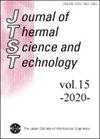Thermal network calculation model for phase change material with SPICE circuit simulator
IF 1.2
4区 工程技术
Q3 THERMODYNAMICS
引用次数: 1
Abstract
The SPICE model of phase change material (PCM) for thermal network transient calculation was investigated. The nonlinear behavior of PCM due to latent heat was modeled by using the voltage dependent current source and the capacitor. A latent heat is stored in the capacitor as electric charges. Corresponding to the PCM phase state, such as solid, liquid and mixed phases, the dependent current source is controlled with PCM temperature and the latent heat quantity of PCM. Since the melting point of PCM has a distribution, the model in which multiple PCM models having different melting points and capacitor capacities were connected in parallel was employed. To validate the numerical simulation model, the aluminum case with PCM sealed inside was prepared. The sample was heated with a rubber heater from the bottom with different heat quantities. The temperature changes of the upper and lower surfaces were measured with thermocouples. The results showed the error between simulated and measured values were below ±4 °C and the calculation time took below real-time. This simulation model can be applied to cooling system optimization and temperature control system. of the maximum latent heat quantity of PCM divided into 15 blocks. The lower melting point (thin line) and the higher melting point (dotted line) show the time changes of the endothermic and exothermic reactions up to the maximum latent heat amount of 35 J, which is half of the maximum latent heat amount of center melting point. It shows the relationship between the change of latent heat quantity for each melting point of PCM and the stepwise change of PCM temperature. It was confirmed that the PCM temperature was maintained while the latent heat was generated at each melting point of each layer. The analysis result with an applied heat flow of 8W shows the latent heat quantity of higher melting point of top PCM layer doesn’t reach the upper limit. It indicates that the third PCM layer was not completely melted. In this experiment, the aluminum case was heated from the bottom. Therefore, it was shown that in the temperature behavior of PCM when the temperature rose, when the amount of heat applied was small, PCM melts in order from the low melting point regardless of the layer. On the other hand, when the amount of heat applied increases, the internal temperature distribution of the PCM increases, which indicates that the lower melting part of PCM in the lower layer melts before the lower melting part of PCM in the upper layer. In the cooling process, it can be confirmed that the upper layer has exothermic reaction earlier than the intermediate layer, and there was also a heat dissipation from the upper surface. The developed model can estimate not only the temperature but also the transient of the latent heat inside the PCM. Thus, this model can be a very useful tool for cooling system optimization.基于SPICE电路模拟器的相变材料热网络计算模型
研究了相变材料(PCM)的SPICE模型在热网瞬态计算中的应用。利用电压相关电流源和电容对PCM的潜热非线性行为进行了建模。潜热以电荷的形式储存在电容器中。对应于PCM的固相、液相和混合相,依赖电流源由PCM的温度和PCM的潜热量来控制。由于PCM的熔点具有一定的分布性,因此采用不同熔点和电容容量的多个PCM模型并联的模型。为了验证数值模拟模型,制备了内部密封PCM的铝壳。用橡胶加热器从底部以不同的热量加热样品。用热电偶测量了上下表面的温度变化。结果表明,模拟值与实测值的误差小于±4℃,计算时间小于实时。该仿真模型可应用于冷却系统优化和温度控制系统。将PCM最大潜热量分为15块。低熔点(细线)和高熔点(虚线)表示吸热和放热反应的时间变化,直到最大潜热35j,即中心熔点最大潜热的一半。给出了PCM各熔点潜热量变化与PCM温度逐级变化的关系。证实了在每一层的每个熔点都产生潜热的同时,PCM温度保持不变。施加热流为8W时的分析结果表明,高熔点的顶层PCM层潜热没有达到上限。说明第三层PCM未完全熔化。在这个实验中,铝壳是从底部加热的。由此可见,当温度升高时,当施加的热量较小时,PCM的熔化顺序从低熔点开始,而不考虑哪一层。另一方面,随着外加热量的增加,PCM内部温度分布增大,这表明下层PCM的下熔化部分先于上层PCM的下熔化部分熔化。在冷却过程中,可以确认上层比中间层更早发生放热反应,同时也有上层表面的散热。所建立的模型不仅可以估计温度,而且还可以估计PCM内部潜热的瞬态。因此,该模型可以成为冷却系统优化的一个非常有用的工具。
本文章由计算机程序翻译,如有差异,请以英文原文为准。
求助全文
约1分钟内获得全文
求助全文
来源期刊
CiteScore
2.30
自引率
8.30%
发文量
0
审稿时长
5 months
期刊介绍:
JTST covers a variety of fields in thermal engineering including heat and mass transfer, thermodynamics, combustion, bio-heat transfer, micro- and macro-scale transport phenomena and practical thermal problems in industrial applications.

 求助内容:
求助内容: 应助结果提醒方式:
应助结果提醒方式:


